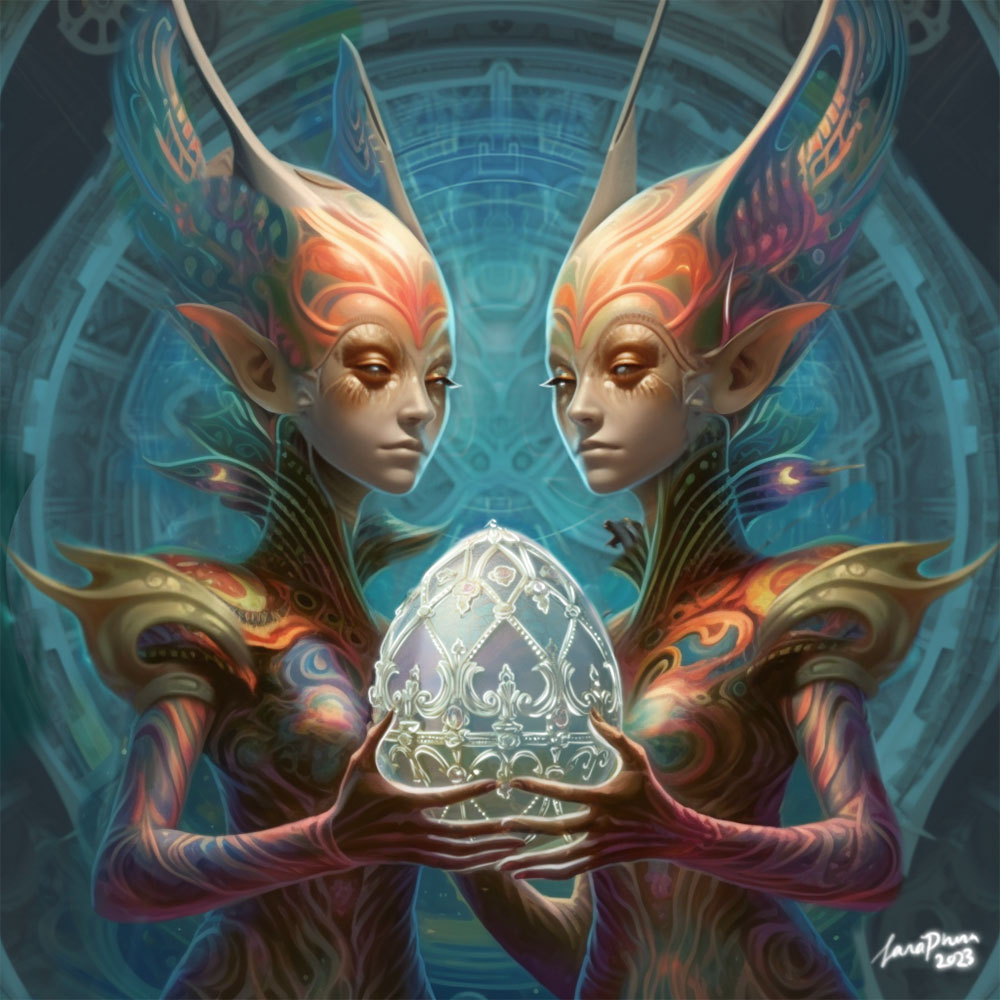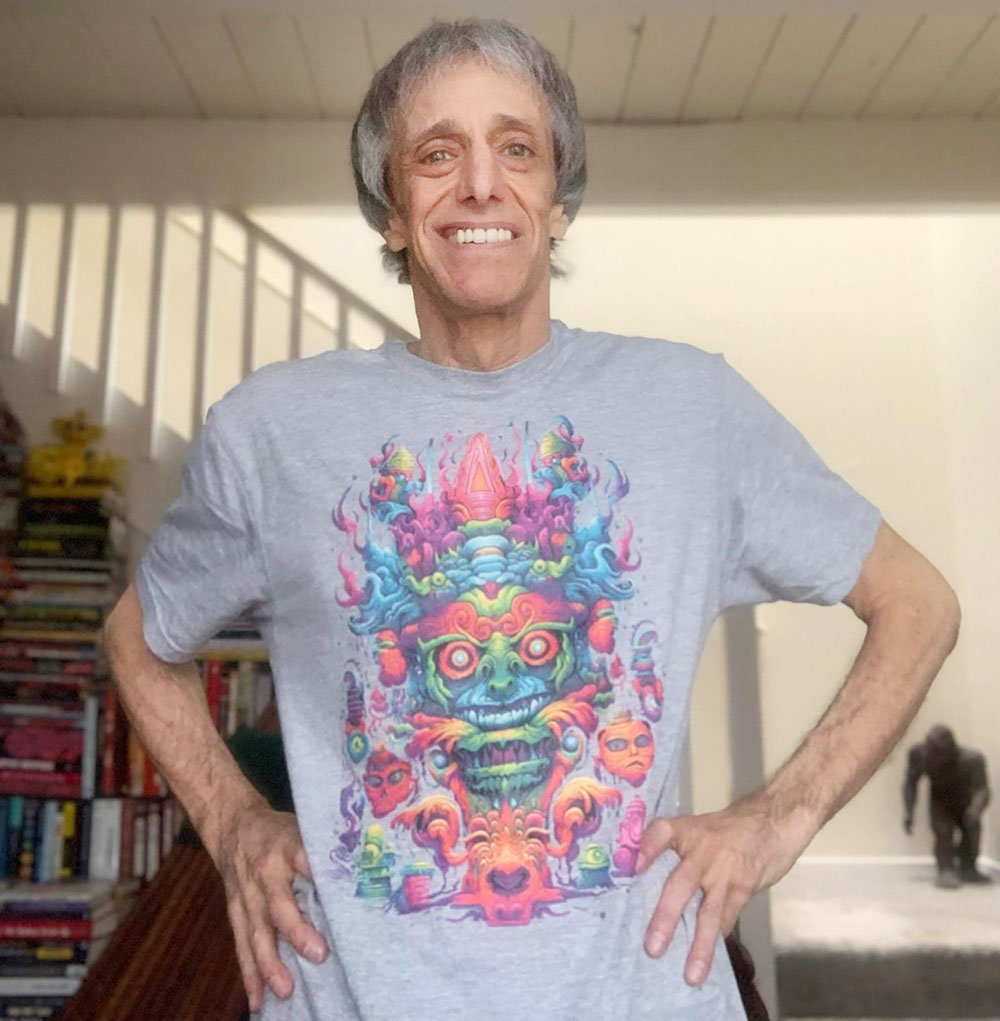We are part of a symbiotic relationship with something which disguises itself as an extraterrestrial invasion so as not to alarm us.
—Terence McKenna
Living just 40 miles south of the Shark Tank, up in the Santa Cruz Mountains, is author David Jay Brown, who could be America’s Psychedelic Laureate.
As anyone with even a slight grasp on the subject knows, talk about psychedelics, which used to be very hush hush, now can be found in plotlines on TV series, Facebook pop-up ads, New York Times bestsellers and local Meetup groups.
David E. Kelley’s Nine Perfect Strangers—where Nicole Kidman, ethereal as always, gives wealthy patrons powerful, perhaps too powerful, psychedelic sessions in a fictional town in California—is a mighty long leap from Doogie Howser, M.D. Welcome to 2024.
As Brown says in the intro to Psychedelics and the Coming Singularity, his freshest collection of interviews with inspirational brains (he is the author of 19 books), “Psychedelics have become so mainstream that there was a hit Broadway musical theater production—Flying Over Sunset—about Cary Grant, Aldous Huxley and Clare Boothe Luce’s LSD experiences. There’s now even a television dating show called Love Is Magic, filmed in Jamaica, where the contestants are tripping on magic mushrooms.”
Can You Pass the Test?
Santa Clara County has always been a hotbed of pioneering psychedelic research, and other, more illicit activities. In 1965, 400 young adults jammed into a home in Naglee Park for the second-ever Acid Test, thereby changing the dominant culture with just one sugar cube. (The first was in Soquel, but San Jose’s was open to the public—and rumors suggest members of the Rolling Stones attended.)
Not long after, in the 1970s, young and barefoot Steve Jobs had the “most profound experiences” of his life on LSD and received the vision of the Apple logo. No need to explain how that was a game changer.
And even today, look at some of the studies Stanford University is doing: Understanding How Ketamine Brings About Rapid Improvement in OCD, The Safety and Efficacy of Psilocybin in Participants With Treatment Resistant Depression, and Stanford Reward Circuits of the Brain Study—MDMA. Face it. San Jose is trippier than you might think.
Time Travel
In the early 1980s, Brown had just graduated from the University of Southern California and was combing through a catalog of classes offered at the Esalen Institute in Big Sur. “I saw that Timothy Leary was giving a workshop at the Esalen. It turned out that was Tim’s last workshop,” Brown says.
“I met a young woman there named Carla, who lived in Santa Cruz at the time, and I hadn’t even heard of the town before. She invited me here and I fell in love,” he recounts. “It was the combination of cafes where people just hung out and talked philosophy, and great bookstores and the redwood forests, and the most beautiful beaches. It was like paradise. I realized a huge part of Santa Cruz’s population had experience with psychedelics, and that was one of the main things that drew me here. Santa Cruz had this exceptionally intelligent community, and everybody here had tripped. Everybody.”
Stranger Truths
In Psychedelics and the Coming Singularity, Brown’s interviews with people from wildly varying disciplines highlight (it is well documented) that not only do people who take DMT (aka N.N-Dimethyltryptamine) encounter the same strange “alien” entities, in the same bizarre plane of existence, but there are also healing properties in DMT that can help those suffering with PTSD and crippling addictions.
So what exactly is going on? Are people just hungry, perhaps ravenous, for undeniable life-changing transcendent moments that can be accessed through psychedelics? Experiences that not only question our sanity, but the very fabric of existence?


Or are we talking more about recreational and medicinal usage? Because if DMT, ketamine, ayahuasca, psilocybin and MDMA can heal trauma, unleash decades of resentment, build bridges between couples who have forgotten how to talk to each other, and pull our legions of veterans out of depression, then that is fantastic. Case closed. Lobby for usage, donate to San Jose’s MAPS (maps.org)—a nonprofit organization that “develops medical, legal, and cultural contexts for people to benefit from the careful uses of psychedelics and marijuana”—and let’s get on with the healing.
But what if we are on the verge of much deeper and stranger truths? What if, as our world disintegrates, we suddenly have some sort of proof that other inhabited dimensions exist?
What Lies Inside
Brown’s other new book—The Illustrated Field Guide to DMT Entities: Machine Elves, Tricksters, Teachers, and Other Interdimensional Beings, coming out this fall—is a meta-analysis of entities that people encounter on the drug DMT. The Field Guide has incredible, trippy, beautiful illustrations, created by Sara Phinn Huntley.
The crossover between the two books is that while DMT usage is on an upswing, it’s happening during a time while there is a looming, fast-approaching “something” that humans are beginning to feel vibrating in their molecules. This unquantifiable event is referred to as the “Singularity”—and it is the point where all of our predictive models (i.e., weather, economics, AI, the future of Hollywood, technology) break down, and we are unable to predict what comes next.
Unfortunately for the dogmatic, you can expect a lot of resistance and denial coming from inside your own head. But for those with limber minds, it is extremely worth checking out Psychedelics and the Coming Singularity. Brown has explored these ideas of new (ancient?) worlds and the technopocalypse with various colorful thinkers (push past the stuff you can’t grok, and keep going).


Brown’s introduction in the book should be published as an essay available to everyone, tacked on doors and read aloud in pubs—like Thomas Paine’s Common Sense. Brown is not prone to sugar-coating the truth. The opening essay sends up the tie-dye Batman signal, because according to Brown, trouble on planet Earth is brewing. In fact, it’s boiling.
It’s a heavy read as Brown makes a compelling case that the end (or beginning?) is nigh. “Here’s the bottom line,” Brown writes. “Humans move around 51 billion tons of carbon into the atmosphere every year and this—along with other more powerful greenhouse gases—is the primary cause of global warming. We need to reduce that number of emissions to zero as quickly as possible and develop carbon-capturing technologies if we want to have any hope of our civilization surviving this next century and not facing the very real prospect of human extinction.”
And like Common Sense, which pushed for independence from England, it’s time for humanity to extricate itself from the chains of corporations—and governments—that favor profits over people. That is if we want to survive. Most of the minds Brown engages with in Psychedelics and the Coming Singularity talk about their experience with DMT, but like a good interviewer, Brown leaves out his own experience.
DJB on DMT
“In 1983,” Brown begins, “the person who turned me on was Bruce Eisner (author of The MDMA Story). Bruce said to me, ‘Oh, I have some DMT. You wanna try it?’ And he opens up his kitchen drawer. It’s one of those kitchen drawers that has every loose nut, bolt, matchbook and odds and ends in it. Spilled on the bottom of the drawer is this orange powder, which he scrapes out. It seemed a little sketchy.
“Bruce brings out this giant bong in the center of the living room,” Brown continues. “He gets out a blow torch, because DMT has to be heated to a high degree. He tells me that I have to take three large hits off the bong. It tastes absolutely disgusting, just like burning plastic. After my first hit, I’m higher than I have ever been on LSD. And I still have two more hits to go. Seconds were expanding into minutes. And while I was holding in my third hit, there was an auditory ‘pop.’ Then, another world popped into my reality and I was able to look around 360 degrees.”


In this new world, Brown encountered creatures and technology that became the subjects for his new Illustrated Field Guide to DMT Entities. “Suddenly,” Brown continues, “amidst a swarm of playful elves, a towering mantis-like scientist notices me and starts inserting electrodes and sensors into my brain. It was testing or measuring something about my responses. And it kept saying, ‘Like this? Like this?’ as though it was changing or adjusting something, and I was tasting bitter, and sweet, and metallic, and different taste sensations. Every possible sensory sensation you could imagine, and a million different other ones, were overwhelming me. I was pleading with this being to stop. It was just too much for me to experience.
“Then, slowly, I felt myself starting to come back to the living room with Bruce, and my very first thought was, ‘Oh. Yeah. I’m a human being that did a drug.’ Not a day has gone by since that experience that I haven’t thought about it. It had such a profound influence on me that I’m still writing and thinking about it today,” he explains.
Epilogue?
Brown is a modern-day Studs Terkel—if, rather than jazz greats and the common person, Terkel had interviewed the psychedelically bent, android-obsessed, radical mystics of the 21st century.
Some other threads in Brown’s Psychedelics and the Coming Singularity: What happens to consciousness after death? Can AI become cognizant? Was there an advanced ancient civilization on earth that we have no record of? Are UFOs the same thing as faeries? And one theory that is making the rounds asks if we are currently living inside a computer simulation.
Brown’s interview with Australian philosopher and cognitive scientist David Chalmers puts a fine point on the need to have a skeptical mind when contemplating the fringe. Brown and Chalmers use the movie The Matrix to explore the healthy, critical approach.
“It’s interesting if the red pill actually was a psychedelic,” Chalmers comments. “I wondered when I first watched The Matrix movie, how is Neo so sure that the red pill has actually led him to escape the simulation? For all we know the red pill is like an amazing psychedelic that introduces you into a new simulated reality. Suddenly he finds himself the master of the universe, on a hovercraft fighting against the machines and so on. It’s like this is, if anything, more like a psychedelic reality. So if I were Neo, I’d start to worry that the red pill hadn’t led him to escape the simulation, but just to go ever deeper into new levels of simulations.”
Is nothing real? Or is everything real? When technology exponentially grows, like fission in a nuclear device, what does it become? Could it become a time machine? Did the Singularity already happen? Like an episode of Lost, have we time traveled back to right before it occurred, so we can stop it?
One thing that is clear in all of David Jay Brown’s books is his love for humanity and his quest for knowledge. Psychedelics and the Coming Singularity will take you on a trip you might never forget. And that’s a good thing.
Find cool archives at DavidJayBrown.com and get information about all of his books on amazon.com—but buy them locally.


